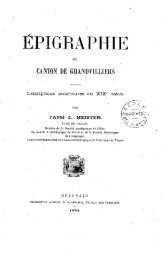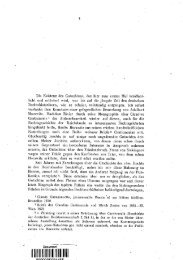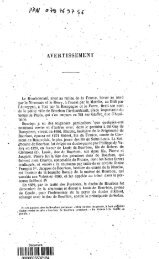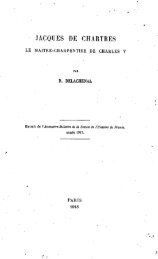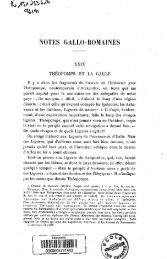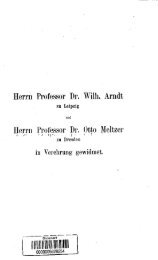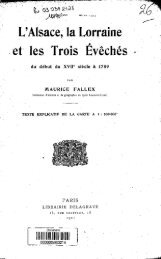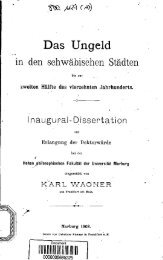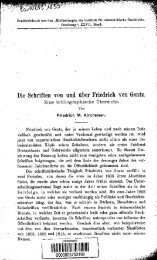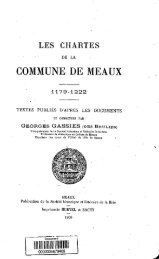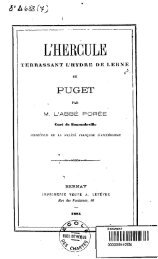4P Li gç(' TRANSACTIONS
4P Li gç(' TRANSACTIONS
4P Li gç(' TRANSACTIONS
Create successful ePaper yourself
Turn your PDF publications into a flip-book with our unique Google optimized e-Paper software.
794 LE LIVRE DE YCONOMIQUE D'ARISTOTE [TRANS. AMER. PHIL. SOC.<br />
least important considerations." However sensible the<br />
observation, it hardly corresponds to the original Latin.<br />
Again, in the same chapter (337a), the French shows<br />
a misunderstanding of the Latin: "Non enirn possibile<br />
non bene ostendentem bene imitari neque in aliis neque<br />
in epitropia. [There can he no good copy without a<br />
good example.]" Oresme turned this to: "Car se les<br />
choses ne apparent hien distincteernent, les servans ne<br />
pevcnt ensuir ou faire selon Ic plaisir du mari et de la<br />
femtne ne en la cure ou garde des choses ne en autres<br />
cvres." This can only mean: "For if the tasks are not<br />
distinctly classified, the slaves cannot follow or fulfill<br />
the wishes of the husband and wife in taking care of the<br />
property or in other tasks." As an example of confused<br />
translation, we may select a sentence at the end of Book<br />
I, ch. 4 (333d) : "Nam lIla que fiunt per ornatum nihil<br />
differunt ab histrionun-i usu tragedias in scena agentiutn.<br />
[For intercourse depending for its charm upon outward<br />
adornment is in no way different from that of the actors<br />
in a tragedy playing their fictitious roles on the stage.]"<br />
Oresme offers as the French equivalent: "Car en tel<br />
apparat fine ont Ic honime et Ia femme qui sunt ensemble<br />
par manage, tel aournement ne differe en rien des<br />
parlers quc Yen seult faire es tragedies." This may be<br />
rendered: "For the outward adornment of the married<br />
couple may be no different from the speeches commonly<br />
associated with tragedies."<br />
The number of such passages in the Yconomique,<br />
although not large, is sufficient to warrant the observation<br />
that translation is a treacherous art even when, as<br />
with Oresme, the translator is completely at home in<br />
both languages. For those who desire to make further<br />
comparison of the French and Latin texts, the latter has<br />
been included as all in this volume. The<br />
vocabulary of the Yconomique is discussed later in Section<br />
4.<br />
Although the title does not indicate it, the Yconomique<br />
contains, like Oresme's three other translations from<br />
the Aristotelian corpus, a running commentary or gloss,<br />
provided by himself. This interpretative material constitutes<br />
approximately two-thirds of the French text.<br />
Whether it deserves to he called commentary or, as<br />
Oresme consistentl y refers to it, gloss, depends upon<br />
the definition given these two terms. In great part, his<br />
explanations are brief and undeveloped—a short sentence<br />
giving a concrete example to illustrate more vividly<br />
an abstract concept or an anticipation of the idea to be<br />
presented in the next translated passage. If we define<br />
a gloss as a short explanatory note and a commentary<br />
as an extended interpretation or discussion of a textual<br />
passage, then we shall have to classify the major part of<br />
Oresme's remarks as glosses, for there are not more<br />
than a half-dozen passages in the Yconomique that<br />
qualify as commentaries according to these definitions.<br />
In supplying this expository material to the original<br />
text Oresme was merely adapting to French the timehonored<br />
practice 1 the expositors 4 the Aristotelian<br />
corpus from the early Greek and Roman commentators<br />
through the great Scholastics of the thirteenth century,<br />
Albertus Magnus and Thomas Aquinas. From the<br />
Alexandrian and Byzantine expositors, the Arabs borrowed<br />
this method of textual exegesis, and as early as<br />
the fourth century Christian scholars began to supply<br />
explanatory glosses to the Bible; Walafrid Strabo's<br />
Glossaria. ordinaria (Ca. 840) on the Vulgate was employed<br />
for several centuries (last edition, Antwerp,<br />
1634) as an authoritative interpretation of the Scriptures.<br />
Among the Jews, the Talmud was originally a<br />
commentary on the Old Testament, to which later generations<br />
added their own commentaries. Thus the tradition<br />
of the gloss and the commentary was part and parcel<br />
of mediaeval learning. Greatly modified, the tradition<br />
is perpetuated in the relatively modern institution of the<br />
explanatory footnote.<br />
Adopting then the expository methods employed in<br />
the Latin commentaries, Oresme translates a passage<br />
from the Latin Economics—a few sentences, a single<br />
sentence, or often merely a phrase, and then he intervenes<br />
with his explanatory comment, frequently a brief<br />
sentence, but occasionally an extended exposition of<br />
several hundred words. With but one exception, in the<br />
extant copies of the Yconomique these glosses follow<br />
immediately after the translated passage. This manner<br />
of linking text and commentary together in sequence,<br />
known as running commentar y, offers the practical advantage<br />
of focusing attention upon the meaning of the<br />
original text; but it incurs at the same time the danger<br />
of breaking the continuity of thought and destroys whatever<br />
unity of style the original ma y possess. The single<br />
exception to this commingling of text and commentary<br />
in the extant copies of the Yconomique is found in the<br />
finely executed manuscript made for Charles V, now in<br />
the private library of the Countess of Wasiers. In this<br />
manuscript, which also contains the Politiques, the gloss<br />
is written in the broad margins surrounding the four<br />
sides of the two narrow columns of translated text; suitable<br />
cross reference marks are used to identify the<br />
glosses with the textual passages under discussion. This<br />
arrangement leaves the original text unbroken; but it<br />
has the disadvantage of dispersing the longer glosses<br />
over several pages, thus increasing considerably the opportunity<br />
for scribal errors and omissions and causing<br />
the reader to lose his place in the translated material.<br />
Among the manuscript copies of the Ycono;niqu-c there<br />
is no example of a third type of paginal arrangement<br />
much less frequently found in commentated works, in<br />
which the text is given in the right hand column, with<br />
cross references to the glosses appearing in the left<br />
hand column. This parallel presentation of text and<br />
commentary was objectionable because it was often<br />
wasteful of expensive parchment, since text and gloss<br />
seldom required equal amounts of space, and the blanks<br />
that resulted from the juxtaposition of disparate quantities<br />
of written matter offended the esthetic sense of




